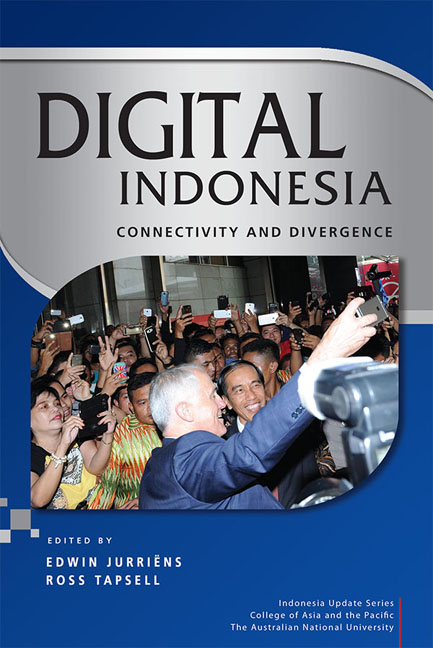Book contents
- Frontmatter
- Contents
- Tables
- Figures
- Contributors
- Acknowledgments
- Glossary
- Map of Indonesia
- 1 Challenges and opportunities of the digital ‘revolution’ in Indonesia
- PART 1 CONNECTIVITY
- PART 2 DIVERGENCE
- PART 3 IDENTITY
- PART 4 KNOWLEDGE
- PART 5 COMMERCE
- 13 Indonesia and the digital economy: creative destruction, opportunities and challenges
- 14 A recent history of the Indonesian e-commerce industry: an insider's account
- 15 The Go-Jek effect
- Index
- Indonesia Update Series
14 - A recent history of the Indonesian e-commerce industry: an insider's account
from PART 5 - COMMERCE
Published online by Cambridge University Press: 12 January 2018
- Frontmatter
- Contents
- Tables
- Figures
- Contributors
- Acknowledgments
- Glossary
- Map of Indonesia
- 1 Challenges and opportunities of the digital ‘revolution’ in Indonesia
- PART 1 CONNECTIVITY
- PART 2 DIVERGENCE
- PART 3 IDENTITY
- PART 4 KNOWLEDGE
- PART 5 COMMERCE
- 13 Indonesia and the digital economy: creative destruction, opportunities and challenges
- 14 A recent history of the Indonesian e-commerce industry: an insider's account
- 15 The Go-Jek effect
- Index
- Indonesia Update Series
Summary
This chapter presents an insider's account of the Indonesian e-commerce industry from 2011 to 2016. Despite several years of impressive growth, the Indonesian digital economy remains in the relatively early stages of inception. This chapter traces the origins of the tech industry from its beginnings in pioneer companies such as KASKUS, Rocket and Go-Jek, through to the now diverse array of start-ups and tech initiatives that are sprouting across the country.
It is hard to believe that only a few years ago, few people in Indonesia believed in the prospects of a domestic e-commerce industry. At that time, newly formed technology companies were struggling with the same problems that beset many other industries, causing many in the market to doubt that a robust industry could ever emerge. The ecosystem yearned for the sustenance of stronger physical infrastructure. Ageing, pre-digital logistics companies groaned under the pressure of parcel delivery growth. Powerful banks and a thicket of financial regulations had failed to nourish a simple, user-friendly online payments provider. Slow, labyrinthine bureaucracy complicated the process of establishing companies and of meeting corporate obligations. Financiers looking at these conditions wondered why they should invest in Indonesia. Most struggled to find an affirming answer.
Over the period from 2011 to 2016, Indonesia's technology industry blossomed despite these many headwinds. A small number of pre-dominantly non-transactional, information-sharing internet companies were overtaken by a vast ecosystem of operators providing physical and digital wares as diverse as food delivery and bridal services. These new companies navigated and exploited the conditions they found in the archipelago—the ebb and flow of industry regulation, the weaknesses of ancillary industries to support their growth and the shortage of people with the experience to help them chart a successful course through these challenges—and were able to build large, well-financed technology companies that attracted the attention and investments of global financiers.
Today, Indonesia's growing digital economy is often touted by econ-omists, entrepreneurs and even President Joko Widodo (Jokowi) as a flagship industry for Indonesia's future economic success. At a stretch, some would even argue that the country has built an internationally relevant technology industry. Several factors provide evidence for this claim. First, Indonesia has its own ‘unicorn’ (a company with a valuation in excess of $1 billion), as confirmed when private equity firm KKR invested $550 million in ride-sharing company Go-Jek in August 2016.
- Type
- Chapter
- Information
- Digital IndonesiaConnectivity and Divergence, pp. 256 - 274Publisher: ISEAS–Yusof Ishak InstitutePrint publication year: 2017

